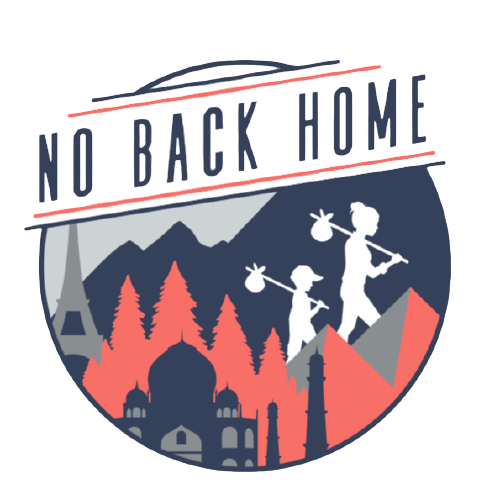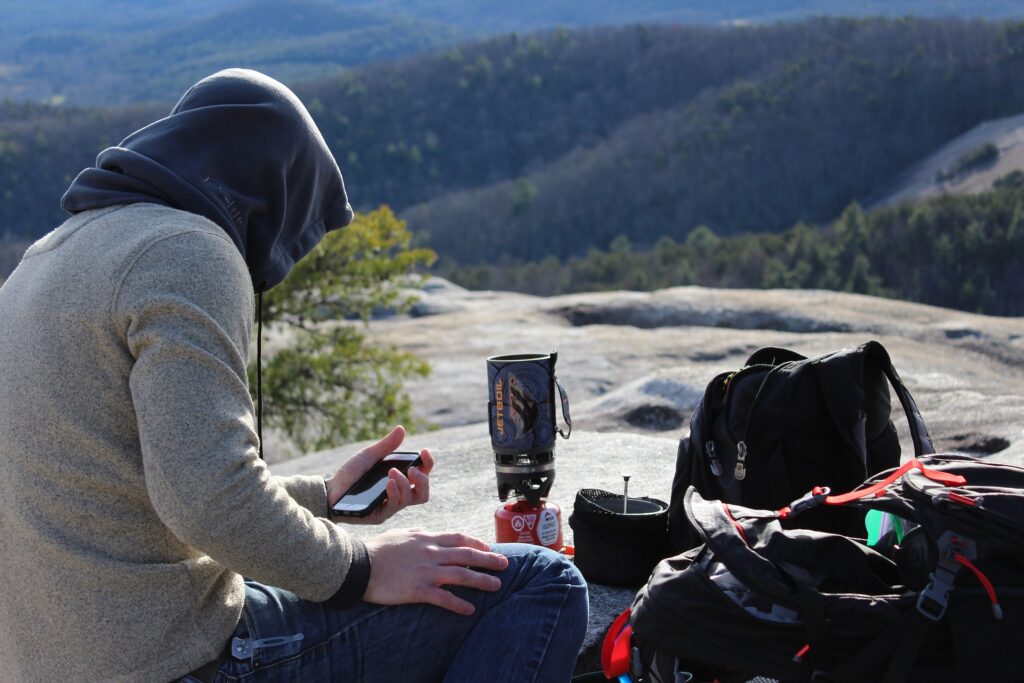Our two favorite things to do in the outdoors in California is hike and camp. Why not combine the two with a backpack camping trip? We know camping in Southern California is very popular with families to couples and folks with their dogs, but for the more adventurous, finding cool spots for backpacking in California is even more exciting.
There are some amazing spots for backpacking in California, from the Bay Area of San Francisco to Southern California and everywhere in between. Some favorite places for backpack camping include Joshua Tree, the Lake Tahoe area, Yosemite National Park and the Kings Canyon and Sequoia National Park areas. Much of these wilderness areas are more ‘hard core backpacking’ for those with experience and the legs to carry themselves further than a couple of mile hike.
For those of you who are new to this outdoor adventure, we share relatively easy, doable backpacking trails here in California to consider for your first (or second or third!) backpacking camping trip with or without kids. As we explore more of the backcountry camping options throughout California, we will update this list.
Don’t miss our top tips and backpacking hacks for beginners!
Jump to a Heading Below
20 Overnight Spots for Backpacking in California
Are you looking to get out into the backcountry? It has become one of our favorite past times to really get off grid and see some really remarkable landscapes that just wouldn’t be possible on day trips. Below we share some easy beginner trails as well as some longer hikes even a few segments of the JMT that can be done on short stints.
Crystal Cove State Park
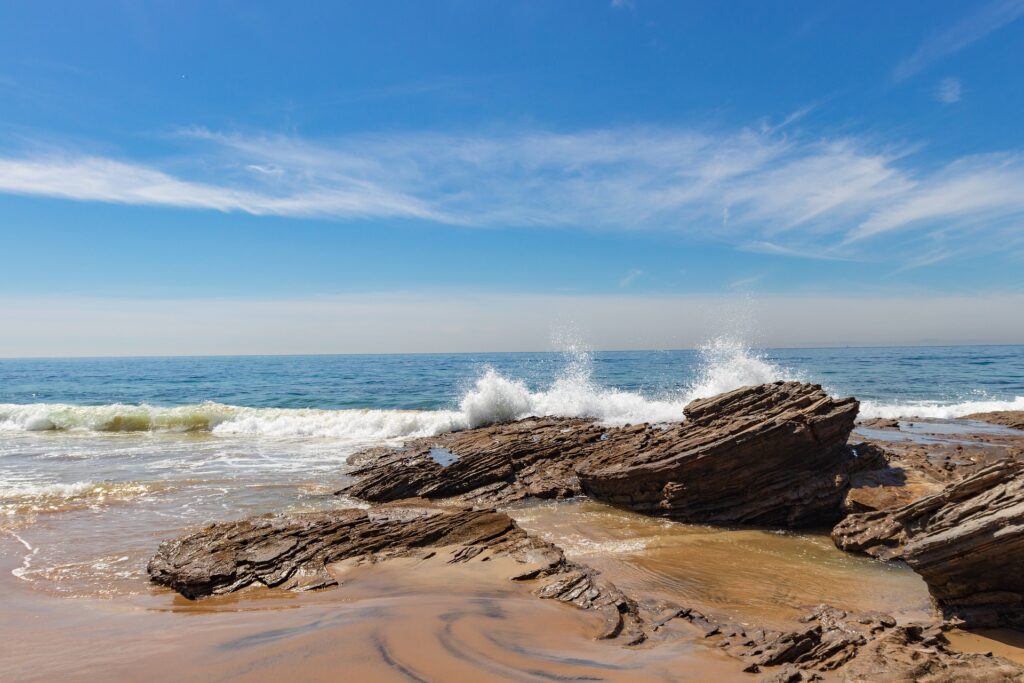 Many people know of Crystal Cove for their great tidepooling and over the beach camping spots, but there are also several primitive backcountry camps that are available. The three different locations are Lower Moro (2.25 mi, 875 elev. gain), Upper Moro (3.15 mi, 975 elev. gain) and Deer Canyon (2.9 mi, 1,110 elev. gain). Even though these aren’t long trails, there is a decent amount of elevation gain to consider especially when you are wearing a weighed down pack!
Many people know of Crystal Cove for their great tidepooling and over the beach camping spots, but there are also several primitive backcountry camps that are available. The three different locations are Lower Moro (2.25 mi, 875 elev. gain), Upper Moro (3.15 mi, 975 elev. gain) and Deer Canyon (2.9 mi, 1,110 elev. gain). Even though these aren’t long trails, there is a decent amount of elevation gain to consider especially when you are wearing a weighed down pack!
The trails are busy during the day with those on a day hike, but once the sun sets, this becomes your little oasis of nature. Crystal Cove State Park is one of the best family friendly backpacking trips as it’s a short trail, meaning you can pack it out and get back home pretty quickly if it all falls apart. Note, there is little shade at the camping area, which can be very hot during the summer months. Also, as with most backcountry campsites, there is no fire allowed other than a camp stove.
Catalina Island Backpack Camping
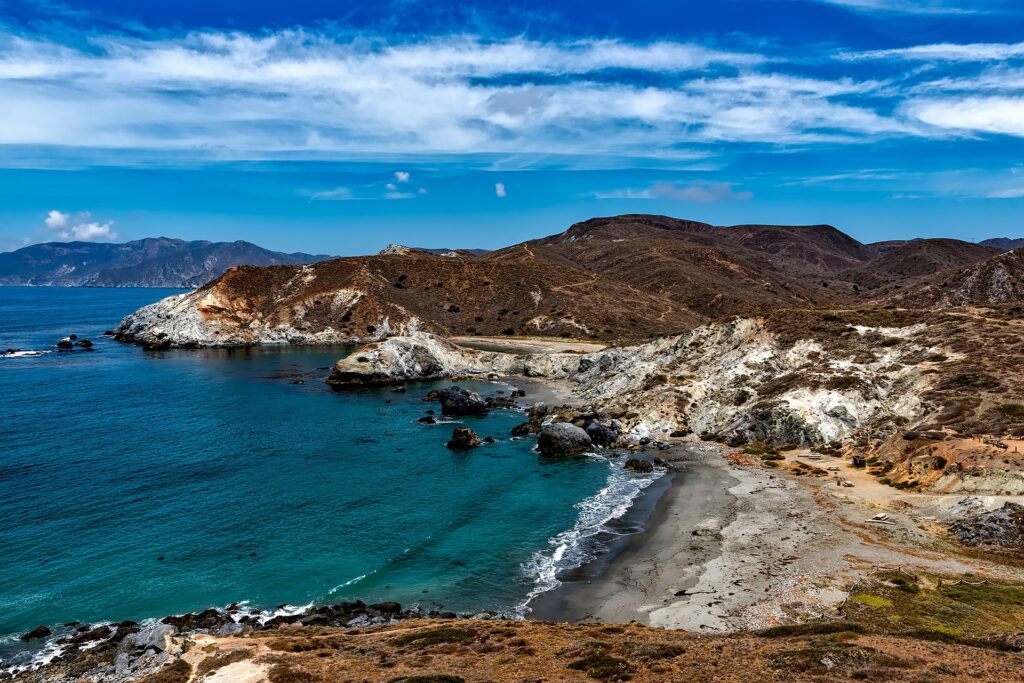 Catalina is often thought of as the best destination for both starter hike-in camping as well as for multi-day thru hikes. The Trans-Catalina Trail is a 40-mile trail that traverses the entire island. Many backpackers do this in 4-5 day camping trips. This epic trail is not easy, but is one that is worth the effort.
Catalina is often thought of as the best destination for both starter hike-in camping as well as for multi-day thru hikes. The Trans-Catalina Trail is a 40-mile trail that traverses the entire island. Many backpackers do this in 4-5 day camping trips. This epic trail is not easy, but is one that is worth the effort.
Don’t despair though, there are options for those without the stamina to go for so long! For the shorter options, you can take the ferry to Two Harbors, where you will hike 5 miles from Two Harbors to Little Harbor. Little Harbor Campground was rated “One of the Best Campgrounds in the West” by Sunset Magazine, so it’s popular and requires advance reservations.
Backpack camping at Catalina does take a bit of advance preparation since you have to take the boat across in advance and camping is allowed only in the established campgrounds, which do require reservations. If Little Harbor is full, you could attempt to hike to Parsons Landing which is a bit further (around 7 miles one way). For both of these sites you can reserve water and firewood in a locker that will be waiting for you. For Little Harbor you can also have an ice chest with food delivered as an added bonus. This is a wonderful addition to help ease your load. Find out all you need to backpack Catalina Island on our ultimate guide.
Channel Islands Camping
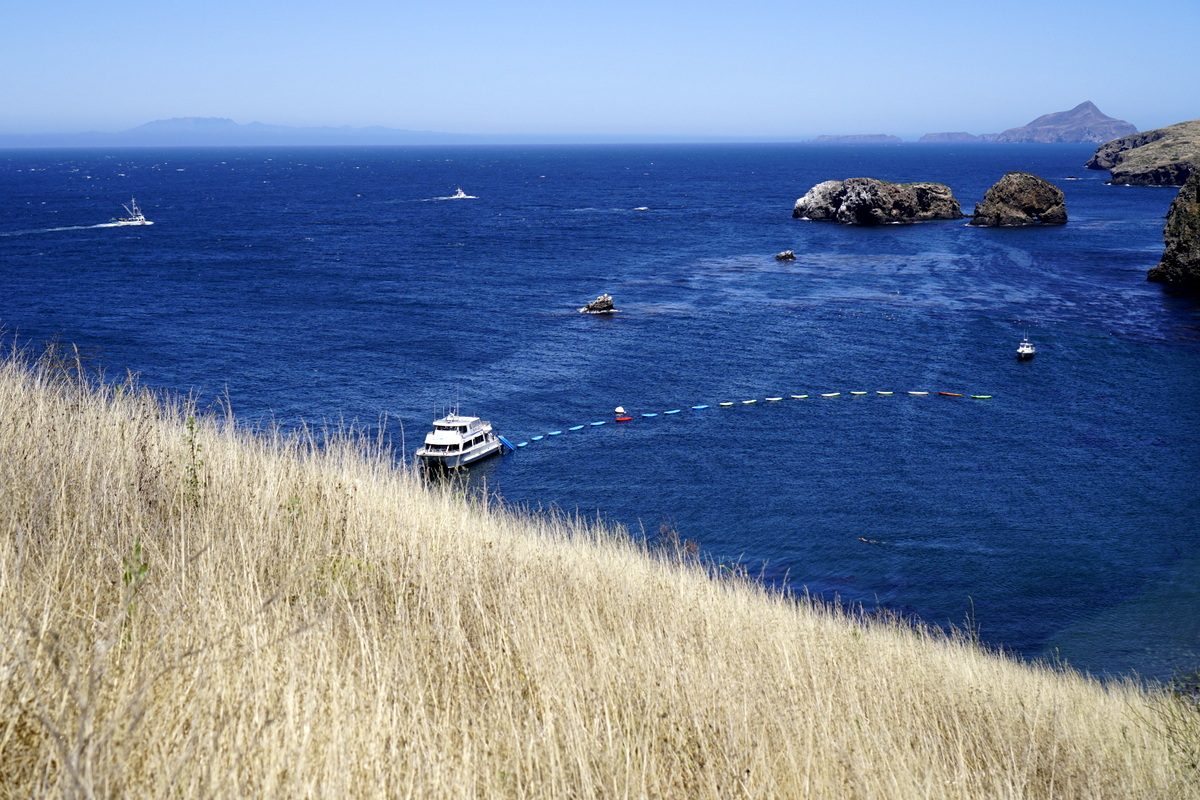 Another island getaway that is a perfect introduction to backpacking in California is the Channel Islands. Some might say this is a cheater option as you don’t have to actually backpack very far to camp on the Channel Islands. You can hike to camp in the backcountry, but you can also get off the boat and walk not too far to an established campground.
Another island getaway that is a perfect introduction to backpacking in California is the Channel Islands. Some might say this is a cheater option as you don’t have to actually backpack very far to camp on the Channel Islands. You can hike to camp in the backcountry, but you can also get off the boat and walk not too far to an established campground.
We recommend this as a great starter backpack camping trip since you have to pack in and out all of your stuff, but you don’t necessarily have to hike that far from where the boat drops you off! It helps you learn what is needed for backpacking camping, how much weight you can carry comfortably without putting too much stress on your body carrying it a long distance.
There is one established campground on each of the islands: above the Landing Cove on Santa Barbara (.25 mile, steep uphill), on the east islet of Anacapa (up stairs about .5 mile hike), at Scorpion Canyon on Santa Cruz (.5 mile flat hike), at Water Canyon on Santa Rosa (1.5 miles from pier, flat), and above Cuyler Harbor on San Miguel (1 mile; steep uphill).
In addition to the established campgrounds, there is limited backcountry camping options as well. Del Norte campsite near Prisoners Harbor on Santa Cruz Island is the only option for year round backcountry camping and is about 3.5 miles hike from Prisoners Harbor. Also, during certain times of year, backcountry beach camping is allowed on Santa Rosa Island, but the nearest site is about a 9 mile hike.
Read up more about what you need to bring with you, how to make reservations and how to purchase boat transfers here.
Mount San Jacinto State Park
 One of the most beautiful areas of Southern California that is often overlooked is the San Jacinto State Park. This park located near Idyllwild is beautiful year round – with snow often late into the season even. Here your options are to either hike in from Idyllwild (a long hike!) or to take the Palm Springs Aerial Tramway up from Palm Springs. Note: Parking is free in the tram parking lot.
One of the most beautiful areas of Southern California that is often overlooked is the San Jacinto State Park. This park located near Idyllwild is beautiful year round – with snow often late into the season even. Here your options are to either hike in from Idyllwild (a long hike!) or to take the Palm Springs Aerial Tramway up from Palm Springs. Note: Parking is free in the tram parking lot.
Backpacking camping at San Jacinto is a great option even with young kids. There are such beautiful meadows and alpine areas you will feel miles away from civilization even if you take the easy way and take the tram up! Once you arrive to the top of the tram, you will need to hike around 2.3 miles to Round Valley. Here you will find water (usually, but bring enough and filtration) and several beautiful established campsites. This is an amazing first backpacking option when the tram is operating and the restaurant is open – meaning you could even make it a multi-night campout without worrying about bringing so much food since you could always pop into the Mountain station for refreshments!
Note: You will need a permit and that permit at the time of writing goes through the regular mail! Applications can be found here.
Hoegee’s Camp in the San Gabriel Mountains
Another great option for those of us looking for backpack trips in Southern California is Hoegees Camp. This backcountry campsite lies along Winter Creek in the canyon adjacent to Sturtevant Falls. Both trails begin from Chantry Flats. (Note: An adventure pass is required to park at Chantry Flats).
And while the hike to Hoegees Camp does not offer a waterfall like Sturtevant Falls, it does offer a 4.25-mile out-and-back hike through a lush canyon with only about 700 feet of elevation change. Hoegee’s Camp was a resort for hikers back before the 50s. Now it offers vault toilets, picnic tables and fire rings on 14 first come first serve sites. These are free and available year round.
The directions are fairly straightforward. Start at Chantry Flats and descend along the paved trail for 0.6 miles to Roberts Camp. After crossing the bridge at the bottom of the pavement, you will come to a junction; make sure to turn left onto Lower Winter Creek Trail at this point. You will pass a few wilderness homes and concrete dams along the way before arriving to Hoegee’s Camp.
Gould Mesa Campground
 One of our favorite backpacking in Southern California camping sites that I even fear to publish is Gould Mesa in the base of the Angeles Forest. From the parking area below JPL, this is a 2 mile, mostly flat hike to the campground. During the day you will see lots of people passing in front of your camp, but as the night falls, you will get this beautiful riverside area all to yourself. We find this to be one of the best backpacking camping sites for newbies. It’s not a long walk in or out, it’s flat and there is a creek nearby to keep the kids occupied all day!
One of our favorite backpacking in Southern California camping sites that I even fear to publish is Gould Mesa in the base of the Angeles Forest. From the parking area below JPL, this is a 2 mile, mostly flat hike to the campground. During the day you will see lots of people passing in front of your camp, but as the night falls, you will get this beautiful riverside area all to yourself. We find this to be one of the best backpacking camping sites for newbies. It’s not a long walk in or out, it’s flat and there is a creek nearby to keep the kids occupied all day!
This campground is a first come first serve site, so you would need to get there super early on a weekend to make sure you procure a site. Week days are still busy, but less competitive. Fires are allowed in the established fire pits and there is one pit toilet for your use.
Piedra Blanca Wilderness Camp
 One of our favorite hikes in the Los Padres National Forest is the Piedra Blanca trail. This is also a great area to check out for your first backpacking in California camping trip. The Piedra Blanca Camp is located on the Gene Marshall-Piedra Blanca Trail about 2.1 miles from the Piedra Blanca trailhead. This is backcountry type camping area with a few fire rings and access to a year round creek. I do believe there are a few secret hot springs out this way, but that would require a much much longer hike to access, which we have yet to do.
One of our favorite hikes in the Los Padres National Forest is the Piedra Blanca trail. This is also a great area to check out for your first backpacking in California camping trip. The Piedra Blanca Camp is located on the Gene Marshall-Piedra Blanca Trail about 2.1 miles from the Piedra Blanca trailhead. This is backcountry type camping area with a few fire rings and access to a year round creek. I do believe there are a few secret hot springs out this way, but that would require a much much longer hike to access, which we have yet to do.
When you are here, you have several options on where to go backpacking. You can go towards the Piedra Blanca Camp which is the left at the trail junction or you can head around 4.2 miles towards Bear Creek Campground. Again these are popular spots for first timers so you won’t be alone out here.
You will need an Adventure Pass to park at the trailhead. Note: the parking lot fills up VERY quickly on weekends, so plan to arrive no later than 8 a.m. Check in with the Ojai Ranger station before you head out to check on current fire restrictions.
Want a packing list for your next car camping trip with kids? Download and print our extensive family camping packing list here!
Barker Valley in the Palomar Mountains
Barker Valley in the Palomar Mountains, located in northeast San Diego County is probably not best for your first backpacking trip, but is a great one when you want a little more challenge. To backpack camp at Barker Valley, you will need to obtain a permit from Cleveland National Forest. The best time of year to camp here is late spring when there is water in the creek and it is not too cold.
The hike isn’t too strenuous, however, you must hike down about 1000 feet in elevation to the river to camp, which means you will hike back up it when you leave. It clocks in at about 6.5 miles total, so it’s not over the top strenuous, but also not one of the easiest. Once you work up to this type of backpacking camping trip, you may never go back to the short and simple hike-in spots! Note: This area is notably colder than you think, so pack for cooler weather!
Joshua Tree Backcountry Camping
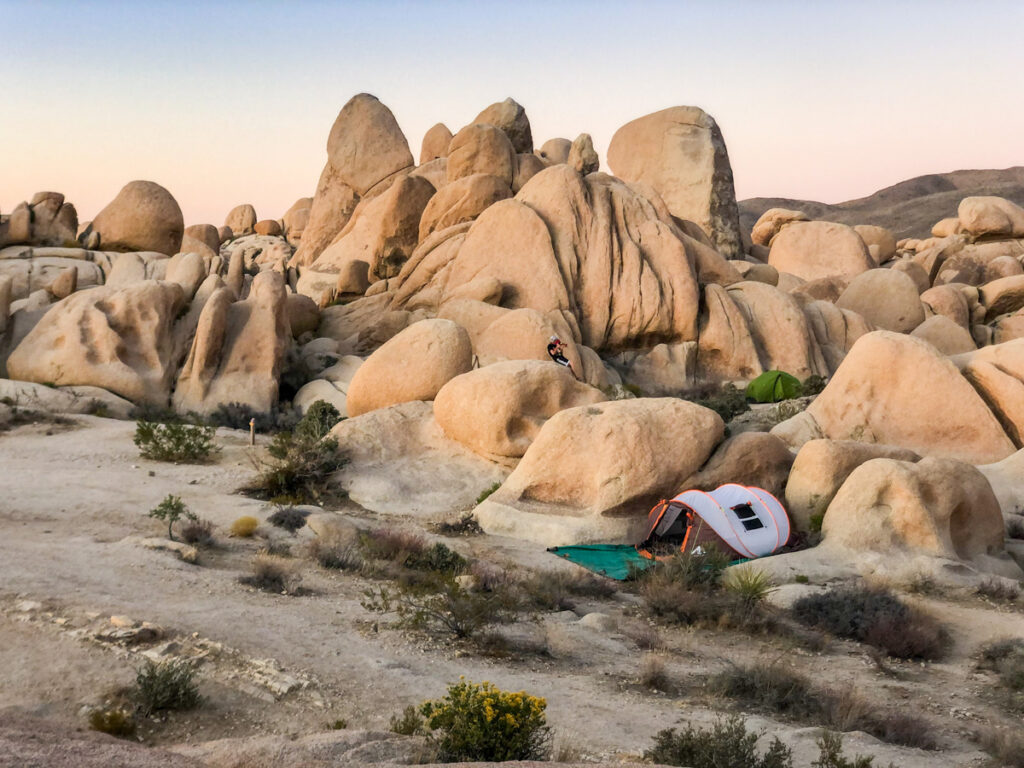 One of the beautiful things about camping in Joshua Tree is there are a number of first come first serve sites throughout the park for car camping, but there are also a number of places and opportunities for backpack style camping both within the park and just outside of it. The biggest obstacle to backpack camping in Joshua Tree is that you have to bring all of your own water.
One of the beautiful things about camping in Joshua Tree is there are a number of first come first serve sites throughout the park for car camping, but there are also a number of places and opportunities for backpack style camping both within the park and just outside of it. The biggest obstacle to backpack camping in Joshua Tree is that you have to bring all of your own water.
The rule here for off grid camping is as long as you are 500 feet from any trail and 1 mile from a road and not on day use land, you are good to go. Make sure that you are also very good at leave no trace. One recommended location is to take the Boy Scout trail and camp west of it.
In addition to the camping options inside the park, there is also dispersed camping just on the outskirts of the actual park. Most campers suggest heading to the 29 Palms area for BLM land. If you need more information on what to do while in Joshua Tree or 29 Palms, we have you covered. We have spent so much time here exploring from when my son was a toddler to a pre-teen!
Cedar Glen Backcountry Camp (aka IceHouse Trail)
Cedar Glen Backcountry Camp in the San Bernardino Mountains is a backcountry camp located about 2.75 miles and about 1,200 feet in elevation from the Icehouse Trailhead (following the Chapman Trail at the split). While this camp is higher elevation, the hike isn’t too strenuous for those carrying their gear. The camp area has space for a group as well as smaller more covered up areas away from the trail. There are no established markers (like fire rings) for camp however.
To camp here you will need to obtain a free permit from the Mount Baldy Visitor Center (909.982.2829). The only fires permitted at the camp are camp stoves also with a prearranged permit. Even though this camp doesn’t have any amenities, it makes a good base for hiking in the area or to try out your backcountry camping skills.
Horsethief Canyon to Pine Valley Creek
Horsethief Canyon Trailhead runs through Cleveland National Forest’s Pine Creek Wilderness and is perfect for backpacking at any one of the shady campsites near Pine Valley Creek. This is a relatively easy hike both into and out of the canyon, with easy access to water, making this a perfect backpacking trip for newbies to get their first taste of backcountry camping.
Follow the trail to around 1.5 miles, where the trail veers away from Horsethief Creek and approaches Pine Valley Creek. Once you reach the banks of the creek at 1.6 miles, you can look around the area for a spot to settle in for the night. While here, enjoy the cottonwood trees and search for some of the grinding holes on the boulders along the west side of the water hole.
You will need to obtain a permit in advance of your overnight trip through the Cleveland National Forest. Fill out this form, fax it to the Descanso District, and wait for them to mail it back to you. Call to find out if they have managed to update their system yet to make it easier!
Kitchen Creek to Fred Canyon (A PCT Hike/Camp)
Have you ever dreamed of hiking the Pacific Crest Trail (PCT)? Well here is your chance to do a portion of the hike and camp along the way too. The beauty of hiking the PCT is the ability to set up camp most places. In this area, dispersed camping is allowed on National Forest land off Kitchen Creek Road and Thing Valley Road.
This short and easy segment (about 3 miles in and 3 miles back) offers nice views of the surrounding area with little incline or elevation change (550 gain if walking uphill from Kitchen Creek and downhill if walking from Fred Canyon). This short distance makes it great for families or beginning backpackers. The best time of year to do this trail is summer, fall or spring as winter can get cold.
Note: A National Forest Adventure Pass is required to park. The trailhead has space for 3-5 vehicles. Parking at the Fred Canyon Road end requires a high clearance vehicle to pass through the road. No facilities until Cibbets Flat at the turn-around area. A visitor’s permit can be obtained locally from the Descanso Ranger District in the Cleveland National Forest.
Buckeye Trail in the Los Padres Forest near Big Sur
Big Sur is one of the most beautiful places in California for camping – whether it is car camping or backpack camping. One of the best trails to try out in the area is the Buckeye Trail. This moderately difficult, albeit beautiful trail has ocean views and travels through oak groves, redwood groves, chaparral.
The Buckeye Trail is 8.6 miles long in total, with several campgrounds dotted along the way. Beginning at the abandoned Salmon Creek Guard Station the trail winds its way north-northwest along the coastal slope, offering sweeping views of the coastline. After passing above and within view of the Southern Redwood Botanical Area, the trail arrives at Buckeye Flat. From Buckeye Flat, the trail continues north through Cruikshank Camp before descending to Villa Creek Camp.
If you can make it all the way to Villa Creek, you will be rewarded with redwood trees and tranquil sounds of flowing water. To start your hike, park at the now closed Salmon Creek Ranger station off Hwy 1.
Recent visitors report an overgrown trail with quite a bit of poison oak at the first .5 mile. Also let it be known it’s a somewhat strenuous hike with somewhat steep drop offs.
Big Pine Lakes
 Big Pine Lakes in the Eastern Sierra Nevadas is a total backpacking in California bucket list experience and may not be accessible for all families. Big Pine Lakes is located in the Inyo forest, about 4 hours from Los Angeles off Hwy 395. This is a popular summer hike for those looking for epic views and photo opportunities. Hiking to Big Pine Lakes is a 5 mile one way steep uphill hike in high elevation, but if you can manage to get up there, you will be rewarded with beautiful glacier lakes and an empty camping area!
Big Pine Lakes in the Eastern Sierra Nevadas is a total backpacking in California bucket list experience and may not be accessible for all families. Big Pine Lakes is located in the Inyo forest, about 4 hours from Los Angeles off Hwy 395. This is a popular summer hike for those looking for epic views and photo opportunities. Hiking to Big Pine Lakes is a 5 mile one way steep uphill hike in high elevation, but if you can manage to get up there, you will be rewarded with beautiful glacier lakes and an empty camping area!
This is a true backcountry camping experience with no established grounds. However, the great news is that there is plenty of fresh cold water (always filter!) so you do not need to bring a ton with you. That said, you are recommended to bring a bear container as there are bears in this neck of the woods. See below for more on recommended gear for any backpack camping trip. This trip also requires a permit for camping that you can get on Recreation.gov.
Chickenfoot Lake in Little Lakes Valley
Another fantastic spot for backpacking in California, also located in the eastern Sierra Nevadas, is at Chickenfoot Lake on the Little Lakes Valley trail. This is a popular spot for fishing and backpacking in California. Beginning your journey from the Mosquito Flat Trailhead, you will hike around 3.5 miles to the lake before setting up camp. Even though you might think 3.5 miles isn’t very far, this is at 10,000+ foot elevation and is considered a moderate hike, especially with a 30 pound pack on! That said, it is only 1000 feet in elevation, making this one of the easiest backpacking trips we have found in the Eastern Sierras.
You will need a wilderness permit which can be found on recretion.gov 6 months in advance or as a walk up option 2 weeks before your hike date. This is a very popular hike, so permits are often difficult to come by.
Obviously there is water available at the lake, but make sure to bring adequate filtration (we love this water filter!). And don’t forget the camera/phone chargers. This is one of the most beautiful sites (other than Big Pine Lakes) on this list and you will want a ton of photos!
An extension on this hike is Rock Creek to Mammoth Lakes clocking in at around 38 miles. You will need transport at the other end, but a cool trail exiting Duck Lake.
Duck Lake & Pika Lake
Another great Eastern Sierra backpacking trip that is worth exploring is to Duck and Pika Lakes outside of Mammoth. We first looked at this hike as part of a 5 day thru hike, but realized it can also easily be done as a simple backpacking trip. Many people do this as a day hike, but it is about 10.5 miles round trip, so why not spend the night up by the lake and explore more from there? Going all the way to Pika Lake, you will see Arrowhead Lake, Skelton Lake, Barney Lake, Duck Lake and Pika. Stunning views make this a favorite so you won’t be alone up there!
The whole hike to Pika Lake and back is about 10.5 miles round trip and roughly 2,000 ft of gain. Again permits are required and can be found at recreation.gov.
John Muir Trail Section Hiking: Tuolumne Meadows to Devils Postpile
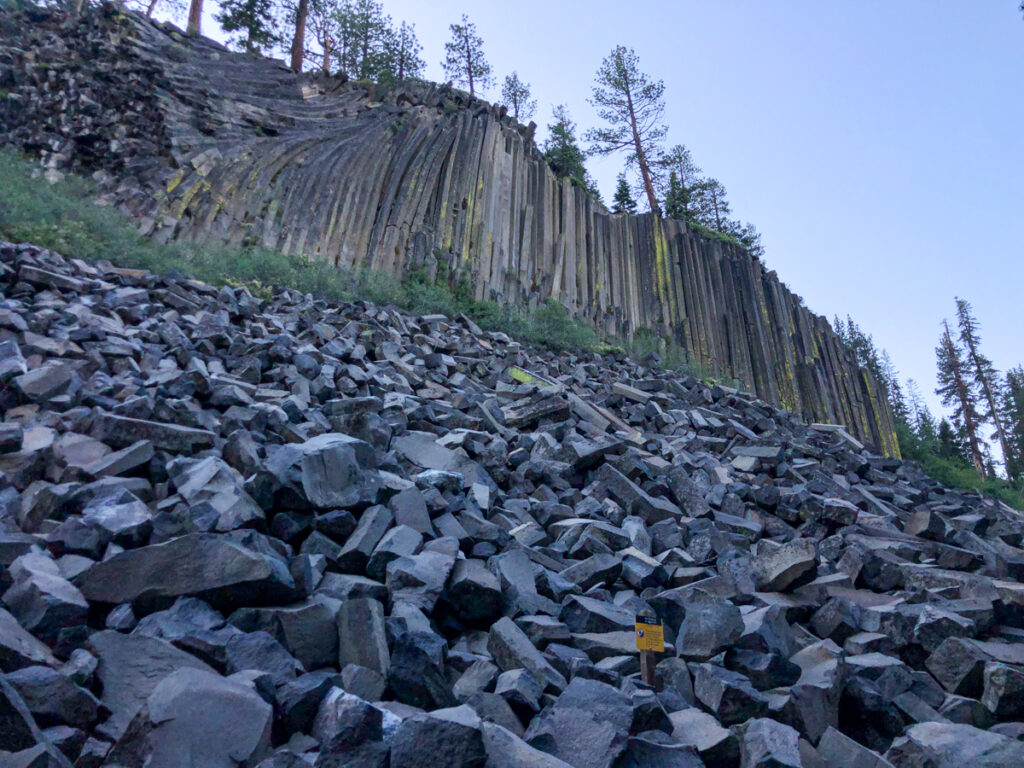 Have you ever wanted to hike the JMT, but just not sure you can manage either the time off or the stamina to hike 220 miles in one go? Well, one option is to hike the JMT in segments. There are a ton of great segments to do as section hikes. One of our favorite is from Tuolumne Meadows to Devils Postpile. This section takes in some of the most scenic parts of the trail such as Thousand Island Lakes.
Have you ever wanted to hike the JMT, but just not sure you can manage either the time off or the stamina to hike 220 miles in one go? Well, one option is to hike the JMT in segments. There are a ton of great segments to do as section hikes. One of our favorite is from Tuolumne Meadows to Devils Postpile. This section takes in some of the most scenic parts of the trail such as Thousand Island Lakes.
This trip can be done in 2-5 nights depending on your fitness and level of comfort. It is about 38 miles one way. In order to do this trail, there are a bit of logistics to sort out, but during the summer months the YARTS and the Reds Meadow Shuttle make this very doable.
Yosemite Thru Hike – Happy Isles to Tuolumne
Another fantastic backpacking in California bucket list trip that everyone hopes to do someday is the first segment of the JMT from Happy Isles to Tuolumne. Again, during summer this trip is made easier with shuttles so that you can go one way without worry. We recommend taking a couple of days to do this trip to really enjoy it. Serious thru-hikers often do it in just 1 night, but we like to take our time! Park your car at Tuolumne where you will finish, take the YARTS shuttle to Yosemite Valley and off you go. This can also be done in reverse which makes it mostly downhill and it is easier to get permits as well.
Backpacking to Minaret Lakes
Although this can be done as a long day hike, why not backpack and spend a little more time here really soaking up the sights? This can easily be a 1-2 night trip. I would recommend hiking to Minaret Lake or as close to it as you can make so that you can see the alpenglow over the minarets in the morning. The round trip for this trail is 16 miles.
Getting here during summer requires a little bit more of effort and planning. If you drive down before 7 a.m. you can drive and park in the overnight hikers parking lot. If not, you will need to take the Reds Meadow/Devils Postpile shuttle to get to the trailhead. Once on the shuttle, you will get off at stop #6. There is water and bathrooms here to use before you set off.
Permits are also required for this hike. You need a permit for Minaret Lake, not the northern section of the JMT.
Backpacking Green Lake Near Bridgeport
Green Lake is a hidden gem tucked away near Bridgeport, California that is a perfect backpacking route for beginners. Getting into the trail requires a long drive down a 9 mile dirt road, but it can be passed with most vehicles easily. This is an out and back trail covering around 6 miles total. An overnight permit is required for any backpacking trip in the Humboldt-Toiyabe National Forest, which can be found on recreation.gov. A beautiful blue-green (actually) lake awaits you. this is perfect for a 1 or 2 night backpacking adventure with plenty of area to explore around the lake.
Things to Consider for Backpacking in California
As you prepare for your first or 10th backpacking trip, you will need to consider a few things.
- Destination: How far can you go? Do you need a permit? Is there water available? What is the best season?
- Gear: What type of gear will you need? Will you pitch a tent or try hammock sleeping? What about filtration for water? Do you have all the lightweight gear necessary?
- Food: What will you eat and drink? Will you be able to pack light enough to carry it all, but have enough food for your trip? How will you cook it? Clean it?
- Leave No Trace: Are you prepared to pack in/out all of your belongings, including your poop?
 Essential Packing List for Backpacking in California
Essential Packing List for Backpacking in California
Check out our Backpacking Pack List (with free printable)
Backpack
A backpack of some sort is a necessity. Most people recommend getting anything from a 45 liter to 60 liter pack. For two adults who can split things up between you, you could probably get away with a bit smaller pack, but bigger will always allow more versatility. Try not to pack your bag to more than 20% of your body weight for maximum comfort.
Backpacking Tent
A lightweight backpacking tent will probably be the most expensive item you will purchase, but in the end it will be worth it to have a light durable tent. We like the Nemo Dagger lightweight tents. They are light, easy to put up and just fits two people with sleeping mats, but there are various options. Remember every little ounce adds up on each item.
Sleeping Pad
We use the Sea to Summit sleeping pad and the Therma-rest Ultralite Pad.
Sleeping Bag
There are a variety of great lightweight sleeping bags. The most important thing to keep in mind is the weather that you plan to camp in and the weight. One great bag is the REI Joule 21, which is a great 3 season pack that is light but also very warm. Other options are Feathered Friends for lightweight down sleeping bags or Enlightened Equipment Ultralight quilts. We love our Zenbivy quilts with sheets that attach to our mats.
Trekking Poles
We love our Black Diamond poles we have had since our trip hiking the narrows in Zion many years ago!
GPS Device
If you plan to be off the radar quite a bit, getting a reliable GPS device is essential. We recommend the Garmin Inreach Mini. You never know when an emergency will strike or you need to contact someone.
Headlamp
Get the smallest lightest one you can. We like the Biolite headlamp, but there are a ton of options. If you do have space, consider also bringing a small solar light and/or power bank as well in case you have battery problems.
First Aid Kit
REI has a ton of great backpacking first aid kits that are also waterproof which can be essential for longer backpacking trips.
Camp Stove
Camp stoves will be one of your most important items for cooking. The top brand used by most backpackers is Jetboil. They have so many different options, which are small, light and boil water quickly. Another option people have recommended is the MCR Pocket Rocket stove and/or the full mess kit with stove. Test out a few, feel how heavy they are, see how they work for you before you set out in the wilderness.
Water Purification
Water purification is an important thing to consider when backpacking in California. Not all sites will have access to water, but if they do, you will always need to filter the water. Many people use the SteriPen, water bottles (we have this one) that filter or even gravity bags that filter between the two bags. Our preferred is the Platypus Quickdraw.
Cups/Bowls
The idea thing here is to bring thats that are super light and can be used for multiple purposes. Check out various options, but this one is useful and light for us.
Leave No Trace Poop Kit
Have your baggie ready for tissues and a trowel handy to dig your holes.
Food
Figuring out what to eat is some of the most difficult decisions for backpacking. Here are a few favorites we have on our list: Instant coffee sticks, apple & cinnamon instant oatmeal, nuts and seeds, coffee glazed almonds, Inner bean black bean snack, banana chips, just mangos, oven baked cheese bites, peanut butter pretzels, mini peanut butter crackers, garlic basil linguine pasta (from Trader Joes: cooks in 2-4 min), chicken broth packets with couscous. Other options are freeze dried foods from REI. We have heard the Pad See You by Backpackers Country is delicious, but haven’t tried it yet!
Have you been to any of these spots for backpacking in California? We have so many on our bucket list including the “Lost Coast” in northern California, adventuring on the John Muir trail and maybe even someday we might find ourselves backpacking near Mount Whitney!
If You Enjoyed This Post, Sign Up To Receive Posts By Email or…
